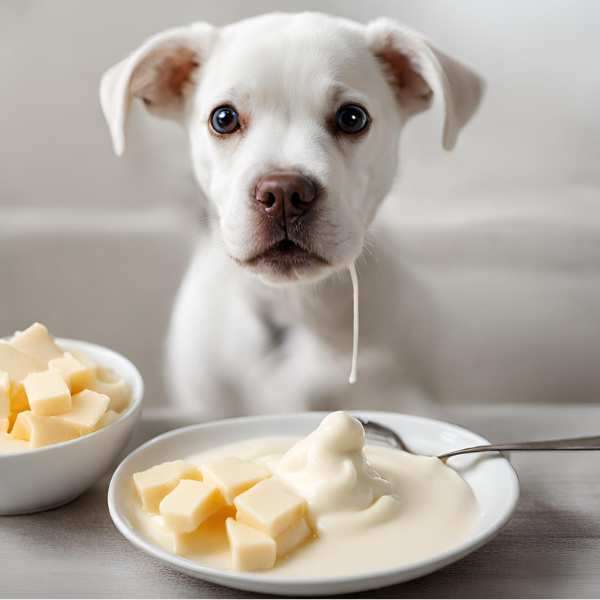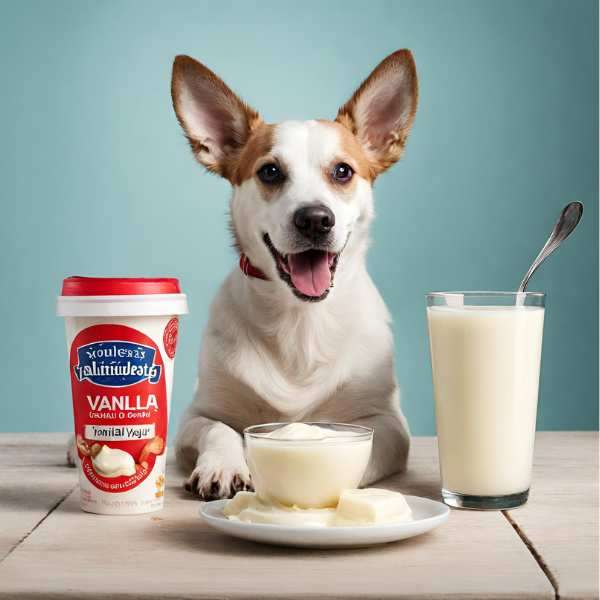Yes, dogs can eat vanilla yogurt in moderation. If you serve plain yogurt that has no sugar can be a good treat for your dog. It has many important minerals and nutrients. It provides a good amount of calcium and protein, and it can also work as a probiotic, helping your dog’s digestive system.
However, it’s important to pick plain, low-fat, or non-fat vanilla yogurt to prevent your dog from consuming excessive sugar and fat. You should always inspect the ingredients to ensure there are no harmful additives like xylitol, which can be harmful to dogs.
While an occasional serving can be a tasty reward, remember that it should only make up a small part of your dog’s diet. The majority of their nutrition should come from well-balanced dog food.
Health Benefits of Vanilla Yogurt for Dogs
Feeding your dog some plain vanilla yogurt in moderation can bring several health benefits:
Digestive Health:
Vanilla yogurt contains helpful live probiotics like Lactobacillus acidophilus and Bifidobacterium. These friendly bacteria can improve your dog’s digestion and maintain a balanced gut environment, which might lower the chances of stomach problems like diarrhea or constipation.
Nutrient Boost:
Vanilla yogurt packs a punch when it comes to essential nutrients. Calcium, for instance, is vital for keeping your dog’s bones and teeth strong, especially important for puppies and older dogs. Protein is another important player which helps to boost muscle movement and overall vitality.
Enhanced Immunity:
Yogurt’s probiotics might give your dog’s immune system a boost by encouraging the production of antibodies and strengthening the body’s defense mechanisms. With a robust immune system, your dog can better fend off infections and illnesses.

Delicious Reward:
Vanilla yogurt provides a tasty and low-calorie way to reward your dog. Whether you use it as a training treat or an occasional prize for good behavior, it can motivate and reinforce positive actions without adding too many calories.
Dental Health:
While it can’t replace regular dental care, the creamy texture of yogurt can help remove plaque and tartar from your dog’s teeth when they chew on it. This can contribute to better oral hygiene and fresher breath.
Cooling Treat:
On hot days, a frozen vanilla yogurt treat can be a refreshing way to help your dog beat the heat. Simply freeze small portions in ice cube trays or create a larger “popsicle” for a hydrating and enjoyable summer snack.
Remember, the key to reaping these benefits is to offer plain, unsweetened vanilla yogurt without any harmful extras.
Health Risks of Vanilla Yogurt for Dogs
Although vanilla yogurt can have advantages when given in moderation, it’s essential to be aware of potential health concerns:

Lactose Intolerance: Some dogs may struggle to digest dairy products like yogurt due to lactose intolerance. This could lead to stomach problems like diarrhea or discomfort.
High Sugar Levels: If you give a floured vanilla yogurt to your dog, then it’s a problem. Flavored vanilla yogurts often contain extra sugars, which can lead to weight gain and dental issues if consumed regularly.
Artificial Sweeteners: You must check yogurt labels for artificial sweeteners like xylitol. They can be harmful to dogs, causing severe health problems such as liver damage and low blood sugar.
Excessive Fat: Yogurt with a high-fat content, especially if consumed regularly, can contribute to obesity and pancreatitis in dogs.
How to Serve Your Dog Vanilla Yogurt?
When it comes to giving your furry friend vanilla yogurt, there are some important steps to follow to make sure it’s a safe and enjoyable treat:

1. Choose the Right Yoghourt: You must pick a yogurt that is plain without any sugars or additives. Make sure it has live probiotics because they can be good for your dog’s tummy.
2. Start Slowly: If your dog hasn’t tried yogurt before, introduce it slowly. Begin with a small amount, like a teaspoon, to see how they handle it and if it affects their digestion.
3. Think About Mixing: You can serve yogurt on its own, mix it into your dog’s regular food, or use it in homemade dog treats. Mixing it with their food can make it more appealing, especially if they’re not used to new things.
4. Keep an Eye Out for Reactions: After your dog tries yogurt, watch them for any bad reactions. Look for signs like a tummy ache, diarrhea, or throwing up. If any of these happen, stop giving them yogurt and talk to your vet.
5. Control Portions: Stick to the recommended serving sizes based on your dog’s size and what they need. Just remember that yogurt should only be a small part of their overall diet.
